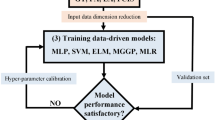Abstract
The purpose of this study is to demonstrate the use of an improved genetic algorithm combining operation tree method (IGAOT) and apply it to monitor the salinity of the Taiwan Strait by using remote-sensing data. The genetic algorithm combining operation tree (GAOT) is a data mining method used to automatically discover relationships among nonlinear systems. Based on genetic algorithms (GAs), the relationships between input and output can be expressed as parse trees. The GAOT method typically has the disadvantages of premature convergence, which means it cannot produce satisfying solutions and performs satisfactorily when applied to only low-dimensional problems. Therefore, the GAOT method is enhanced using an automatic incremental procedure to improve the search ability of the method and avoid trapping in a local optimum. In this case study, an IGAOT is used to determine the relationship between the in situ data on the salinity of the Taiwan Strait and the data on the spectral parameters, seven wavebands, of a Moderate-Resolution Imaging Spectroradiometer (MODIS) sensor. The results indicate that the IGAOT model performs more favorably than do the GAOT and linear regression (LR1 and LR2) models, exhibits higher correlation coefficients, and involves fewer estimating errors. The results of this study indicate that the proposed technique is useful for estimating the Taiwan Strait salinity.











Similar content being viewed by others
References
Burrage, D., Wesson, J., & Miller, J. (2008). Deriving sea surface salinity and density variations from satellite and aircraft microwave radiometer measurements: Application to coastal plumes using stars. IEEE Transactions on Geosciences and Remote Sensing, 46, 765–785.
Canfu-Paz, E. (2000). Efficient and accurate parallel genetic algorithms. Boston: Kluwer Academic.
Chang, F. J., Chen, L., & Chang, L. C. (2005). Optimizing the reservoir operating rule curves by genetic algorithms. Hydrological Processes, 19, 2277–2289.
Cheng, M., Firdausi, P., & Prayogo, D. (2014). High-performance concrete compressive strength prediction using genetic weighted pyramid operation tree (GWPOT). Engineering Applications of Artificial Intelligence, 29, 104–113.
Cooper, N. (1988). The effect of salinity on tropical ocean models. Journal of Physical Oceanography, 18, 697–707.
Davis, L. D. (1991). Handbook of genetic algorithms. New York: Van Nostrand Reinhold.
Dekker, A., Vos, R., & Peters, S. (2002). Analytical algorithms for lake water TSM estimation for retrospective analyses of TM and SPOT sensor data. International Journal of Remote Sensing, 23, 15–35.
Eshelman, L. J., & Schaffer, J. D. (1991). Preventing premature convergence in genetic algorithms by preventing incest. In: Proceedings of the 4th International Conference on Genetic Algorithms, San Mateo, United State.
Fogel, D. (1994). An introduction to simulated evolutionary optimization. IEEE Transactions Neural Networks, 5, 3–14.
Font, J., Boutin, J., Reul, N., Waldteufel, P., Gabarró, C., Zine, S. et al. (2006). An iterative convergence algorithm to retrieve sea surface salinity from SMOS L-band radiometric measurements. In: IEEE International Geoscience and Remote Sensing Symposium, pp. 1697–1701.
Gabarro, C., Vall-Llosera, M., Font, J., & Camps, A. (2004). Determination of sea surface salinity and wind speed by l-band microwave radiometry from a fixed platform. International Journal of Remote Sensing, 25, 111–128.
Goldberg, D. E. (1989). Genetic algorithms in search optimization and machine learning. Boston: Addison-Wesley.
Hsu, C. S., Chen, L., Wang, T. S., & Hsu, Y. T. (2013). Applying genetic algorithm operation tree for predicting the total phosphorus in a reservoir. Journal of Convergence Information Technology, 8, 103–110.
Jan, S., Sheu, D., & Kuo, H. H. (2006). Water mass and through flow transport variability in the Taiwan strait. Journal of Geophysical Research, 111, 1–15.
Khorram, S. (1982). Remote sensing of salinity in the san Francisco bay delta. Remote Sensing of Environment, 129, 15–22.
Lavery, P., Pattiaratchi, C., Wyllie, A., & Hick, P. (1993). Water quality monitoring in estuarine waters using the landsat thematic mapper. Remote Sensing Environment, 46, 265–280.
Lien, L. C., Yeh, I., & Chen, M. Y. (2006). Modeling strength of high performance concrete using genetic algorithms and operation tree. Journal of Technology, 21, 41–54.
Marghany, M. (2009). Least square algorithm for sea surface salinity retrieving from modis satellite data. In: Proceedings of the 2009 IEEE International Conference on Signal and Image Processing Applications, Kuala Lumpur, Malaysia.
Mitchell, M. (1996). An introduction to genetic algorithms. Cambridge: Bradford Book, MIT Press.
MODIS Web, http://modis.gsfc.nasa.gov/about/specs.html.
Palacios, S., Peterson, T., & Kudela, R. (2009). Development of synthetic salinity from remote sensing for the Columbia river plume. Journal of Geophysical Research, 114, 1–14.
Peng, C. H., Yeh, I. C., & Lien, L. C. (2010). Building strength models for high-performance concrete at different ages using genetic operation trees, nonlinear regression, and neural networks. Engineering with Computers, 26, 61–73.
Sonia, Z., Boutin, J., Waldteufel, P., Jean-Luc, V., Thierry, P., & Pascal, L. (2007). Issues about retrieving sea surface salinity in coastal areas from SMOS data. IEEE Transactions on Geosciences and Remote Sensing, 45, 2061–2073.
Wong, M., Lee, K., Kim, Y., Nichol, J., Li, Z., & Emerson, N. (2007). Modeling of suspended solids and sea surface salinity in Hong Kong using aqua/MODIS satellite images. Korean Journal of Remote Sensing, 23, 161–169.
Author information
Authors and Affiliations
Corresponding author
About this article
Cite this article
Chen, L., Alabbadi, B., Tan, CH. et al. Predicting Sea Surface Salinity Using an Improved Genetic Algorithm Combining Operation Tree Method. J Indian Soc Remote Sens 45, 699–707 (2017). https://doi.org/10.1007/s12524-016-0637-7
Received:
Accepted:
Published:
Issue Date:
DOI: https://doi.org/10.1007/s12524-016-0637-7




